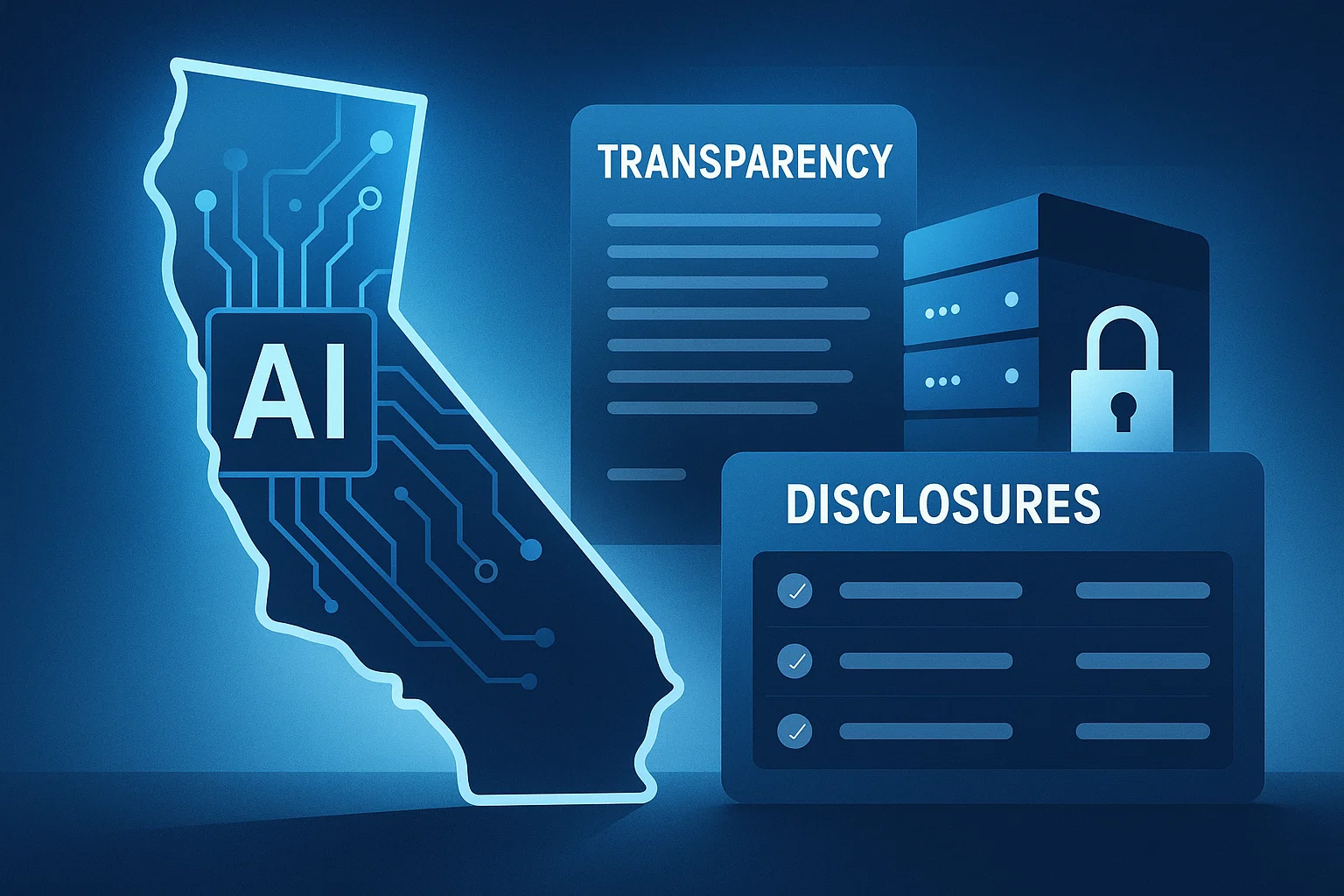The california ai transparency bill requires covered AI developers to disclose safety plans, reporting, and governance, so you should inventory models, run impact checks, and publish required disclosures quickly to reduce legal and reputational risk.
Introduction
The california ai transparency bill is the focus of this guide, and this post is informational with practical, step-by-step actions so you can fix low CTR titles and weak meta while preparing real compliance work. You’ll get a clear explanation of what the bill requires, a migration and disclosure checklist, code to automate checks, and vetted tools to speed adoption. I’ll refer to official state guidance and major coverage so you know where to look for the authoritative text. Governor of California
In my experience, teams that pair a tight disclosure template with a public transparency page reduce review friction and build user trust quickly, so I’ll show you copy-ready items and a rollout plan you can implement with minimal disruption.
What the california ai transparency bill is and why it matters
The california ai transparency bill is a state law aimed at increasing public disclosure around advanced AI systems and their safety frameworks, targeted at large developers and systems that present substantial public risk. It asks covered entities to publish governance frameworks, safety measures, and reporting mechanisms so the public and regulators can evaluate their approach. LegiScan
Who it covers, broadly
The law focuses on large AI developers and systems that meet defined thresholds, for example high compute models or those deployed at scale. That means many organizations that build or expose advanced models will need to prepare public-facing disclosures and internal evidence showing how risks are managed. Reuters
Why it matters for your product and SEO
Beyond compliance, transparent policies boost user trust, which improves clickthrough and conversion when you highlight disclosures in product pages and metadata. Preparing disclosures early also reduces last-minute engineering scrambles, and gives your marketing team content that improves CTR and authority.
Key semantic ideas to use across pages: governance framework, safety mitigation, impact reporting, and developer accountability.
The official state announcement frames the law as a transparency framework for frontier models, requiring public safety commitments and reporting. (gov.ca). Governor of California
Major reporting highlights that the law requires public disclosures from large AI developers on safety plans and mitigation steps. (Reuters). Reuters
How to comply and implement required disclosures — step-by-step
Follow these practical steps to prepare your organization and your site for required disclosures and public transparency.
- Inventory models and services. Catalog deployed models, endpoints, who owns them, and where keys and logs live. Prioritize externally facing systems and high-impact models.
- Classify coverage and thresholds. Determine which systems meet the bill’s coverage criteria, and tag them as covered, candidate, or exempt. Keep evidence supporting each classification. LegiScan
- Draft your public transparency page. Create a concise framework page that covers governance, safety policies, reporting contact, and a short summary of mitigation measures. Use clear headings and a simple disclosure template.
- Run internal impact assessments. For covered systems, run an impact assessment covering safety risks, misuse, privacy exposures, and mitigation plans. Store results in an auditable repository.
- Publish and monitor. Publish the transparency page and update it as your mitigation posture evolves. Add a changelog and contact channel for reporting incidents.
- Automate checks and audits. Implement automated validations that confirm the public page exists, required fields are present, and internal evidence is up to date before any major release.
Copy-ready disclosure template (JSON)
{
"product": "Model X",
"owner": "Team Y",
"public_summary": "Short description of model purpose and limits",
"safety_measures": ["access controls", "rate limits", "red-team testing"],
"report_contact": "security@example.com",
"last_review": "2025-XX-XX"
}
Explanation: Use a structured template to render both a public page and machine-readable metadata for audits, adapt fields to match the law's requirements. Store templates in version control.
Quick tech example, Python check for required fields
# python
# Minimal check to validate a disclosure JSON file has required keys
import json
REQUIRED = {"product", "owner", "public_summary", "safety_measures", "report_contact"}
def validate_disclosure(path):
try:
with open(path, "r") as f:
data = json.load(f)
missing = REQUIRED - set(data.keys())
if missing:
raise ValueError(f"Missing fields: {', '.join(missing)}")
return True
except Exception as e:
# Minimal error handling, log error and re-raise for caller to handle
raise RuntimeError("Disclosure validation failed") from e
Explanation: Run this as part of CI to block releases if the public disclosure is incomplete.
Best practices, tools, and resources
Use tools and patterns that make transparency manageable, auditable, and shareable.
Best practices
- Keep a single source of truth for all disclosures, and render tailored public and internal views.
- Automate updates from your deployment pipeline to the public transparency page, with human review gates.
- Use plain language summaries along with technical appendices to serve both the public and auditors.
Recommended tools
- Model registry with metadata support
- Pros: stores model provenance and versions, supports audit exports, Cons: additional infra and integration.
- Install/start tip: connect to your CI to register every model build.
- Static site generator or CMS for disclosures
- Pros: simple publishing workflow, review and changelog features, Cons: requires content governance.
- Install/start tip: generate a JSON endpoint for audits, and a human-readable page for public view.
- Automated compliance checks in CI
- Pros: prevents incomplete disclosures from being deployed, Cons: teams must maintain checks as policy changes.
- Install/start tip: add disclosure validators to your pre-deploy pipeline.
Tool choice note: pick tools that export machine-readable evidence for audits and enable easy rollback of disclosures.
Challenges, legal and ethical considerations, troubleshooting
Legal, operational, and ethical issues arise when publishing transparency material. Plan for them early.
Common challenges
- Sensitive internal details vs. public transparency. Balance transparency with IP and security. Provide summaries, not raw internal logs.
- Vendor and third-party models. Partner models may limit what you can disclose, requiring redacted or summarized information.
- Operational burden. Maintaining accurate disclosures needs dedicated roles or automation to avoid stale pages.
Compliance checklist
- Inventory models and classify coverage with evidence.
- Publish a public transparency page with governance summary, safety measures, and a reporting contact.
- Maintain internal impact assessments and archive them for audit.
- Implement automated CI checks that validate public disclosures before deployment.
- Create an incident reporting and update workflow for transparency updates.
Alternatives and mitigation
If partners block specific disclosure details, provide a high-level summary and offer a secure review path for authorized auditors. If disclosure updates create legal risk, involve legal counsel for redaction guidance.
Coverage from authoritative outlets notes that the law asks large AI developers to publish safety frameworks and reporting mechanisms to enhance public oversight. (The Verge, Reuters). The Verge
How this affects your content and CTR
On-page SEO and CTR improve when transparency is visible and easy to find. Add a short disclosure snippet on product pages and include the transparency page in structured data to surface in search results.
Practical copy tips for better CTR: use benefit-led titles like “Transparency, Safety, and How We Protect Your Data”, include “Transparency” in meta titles, and add a clear CTA to the transparency page from product pages.
Bold key takeaways:
- Publish a concise transparency page and keep it current.
- Automate validation to avoid stale disclosures.
- Balance public detail with security and legal constraints.
Conclusion and CTA
The california ai transparency bill raises the bar for public disclosure and governance, but you can meet the requirement with a pragmatic plan: inventory, template disclosures, hybrid public/internal views, and CI validation. Start with a focused pilot, automate checks, and publish a clear transparency page that builds trust and improves clicks. Act now to reduce legal exposure and show leadership in responsible AI.
Welcome to Alamcer, a tech-focused platform created to share practical knowledge, free resources, and bot templates. Our goal is to make technology simple, accessible, and useful for everyone. We provide free knowledge articles and guides in technology, offer ready-to-use bot templates for automation and productivity, and deliver insights to help developers, freelancers, and businesses. For custom compliance integrations, disclosure templates, or engineering support, contact Alamcer to accelerate your rollout.
FAQs
What is california ai transparency bill?
The california ai transparency bill is a state law that requires covered AI developers to publish governance frameworks, safety measures, and reporting contacts, aimed at improving public oversight of high-risk AI systems.
Who must publish disclosures under the bill?
Large developers and systems meeting statutory thresholds are typically covered, prioritize systems with high compute, public exposure, or significant societal impact, check the bill text and classification rules for exact thresholds. LegiScan
How do I create a public transparency page?
Use a concise template with a public summary, safety measures, reporting contact, and a changelog, host it on your corporate site, and expose a machine-readable endpoint for audits.
Can I redact sensitive information from disclosures?
Yes, provide clear summaries while protecting trade secrets and operational security, document redaction reasons internally and offer secure auditor access if required.
What tech changes are needed to comply?
You will need a registry for models, CI checks to validate disclosures, and an audit log of approvals, plus a public page generator that draws from your metadata store.
How can I automate disclosure validation?
Add a CI step that validates required JSON fields or checks the public page for required headings, block releases on failures, and alert owners for remediation.
california ai transparency bill
The california ai transparency bill establishes public disclosure and reporting obligations for covered AI systems, requiring governance frameworks and safety commitments.
What if a partner model prevents disclosure?
If third-party terms limit disclosure, provide high-level summaries and document compensating controls and secure review processes for auditors.
How should marketing use transparency to improve CTR?
Place a clear link to your transparency page in product snippets, use benefit-led wording in titles and meta, and include trust signals like third-party audits or certifications.
Who can help implement disclosures and automation?
For templates, automation scripts, or custom integrations, contact Alamcer for practical templates and development services to speed your compliance work.
Compliance and disclaimer
This post provides general information, not legal advice. Follow applicable privacy, consumer protection, and disclosure laws, and consult legal counsel for obligations and redaction guidance. For questions about specific regulatory impact or multi-jurisdictional issues, consult a qualified professional.



